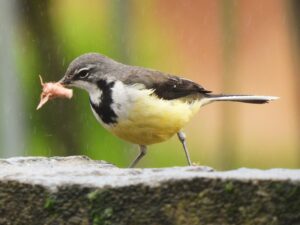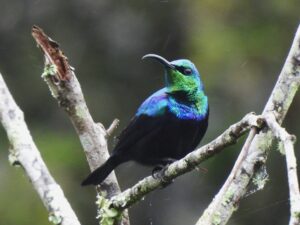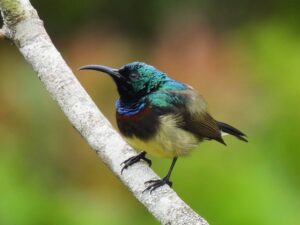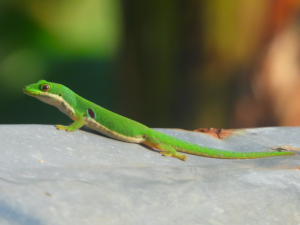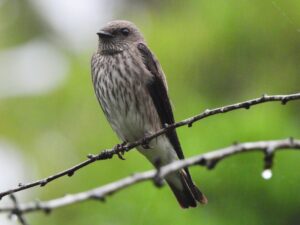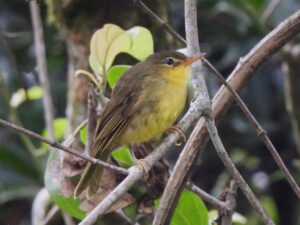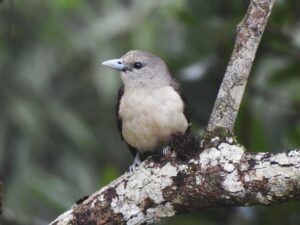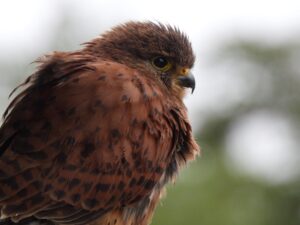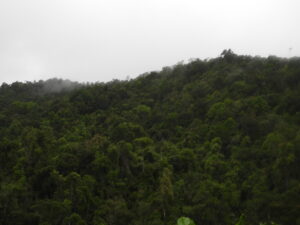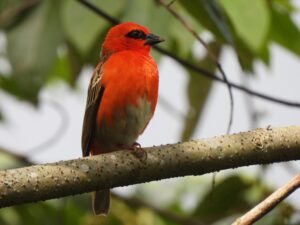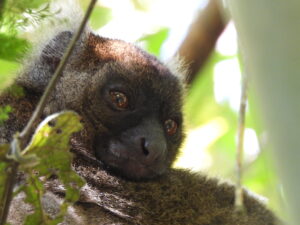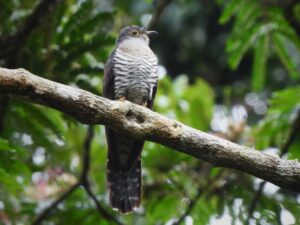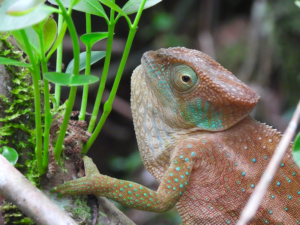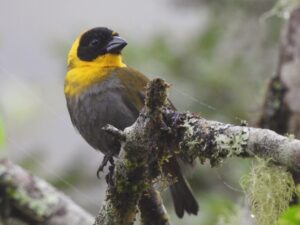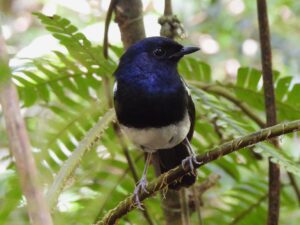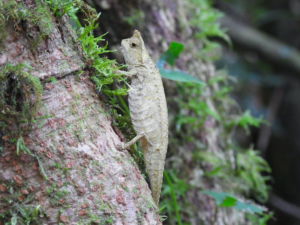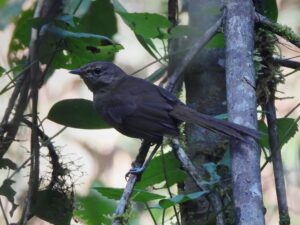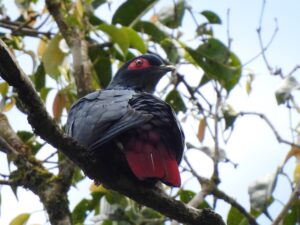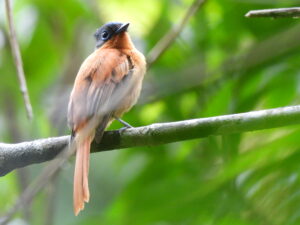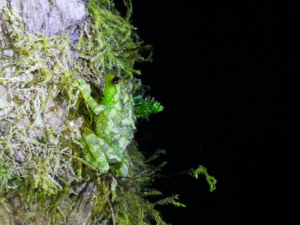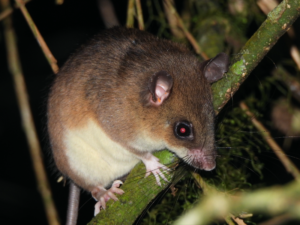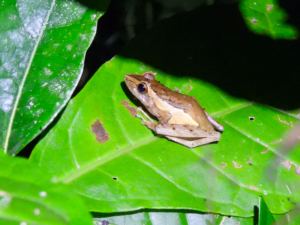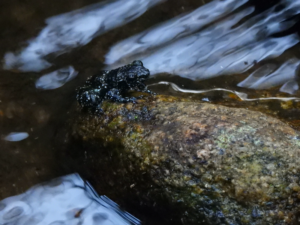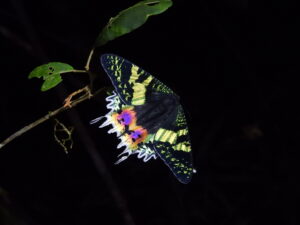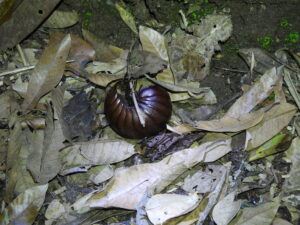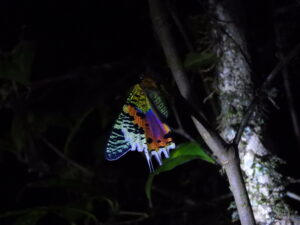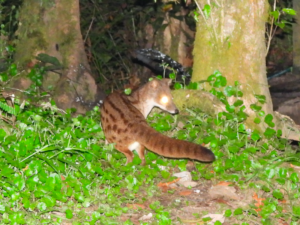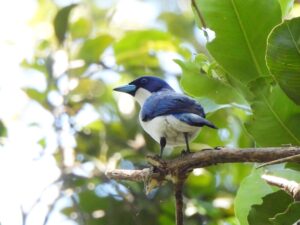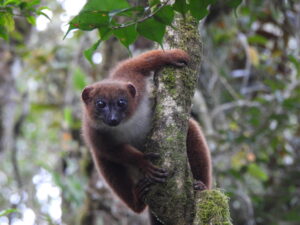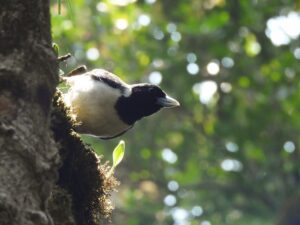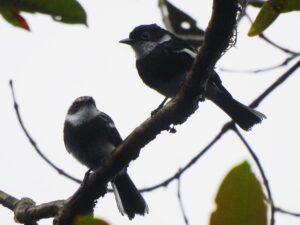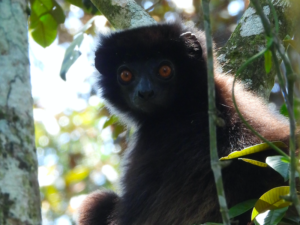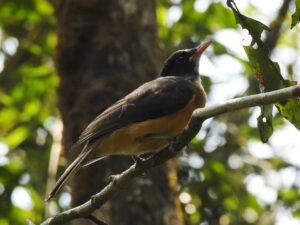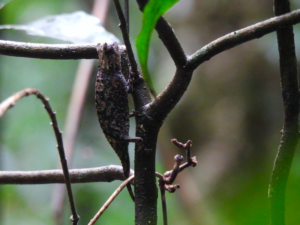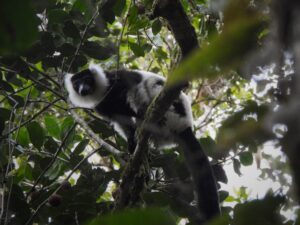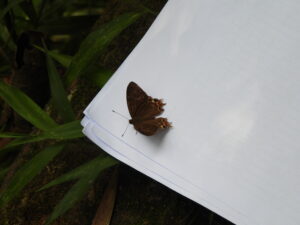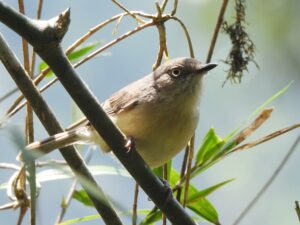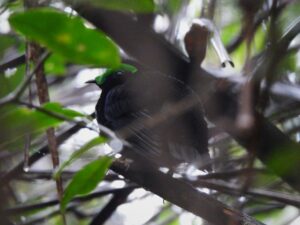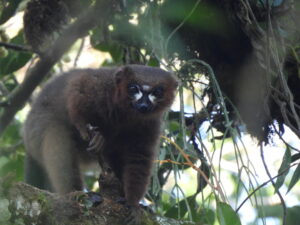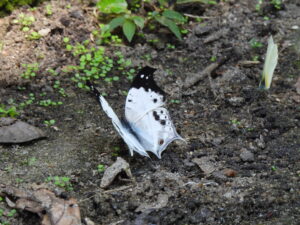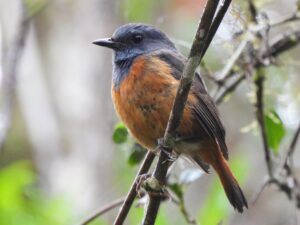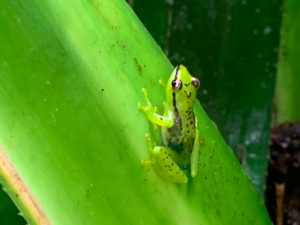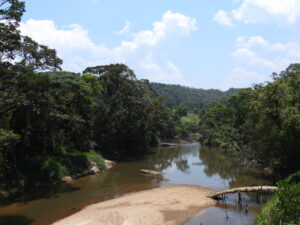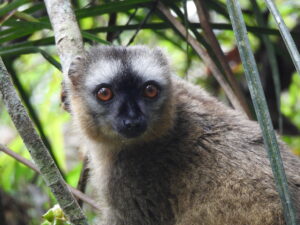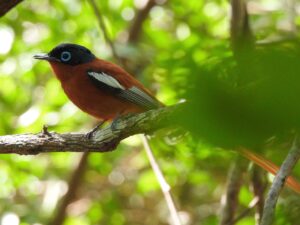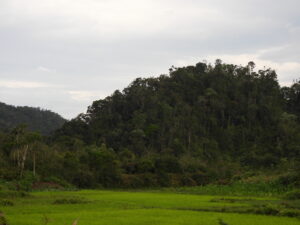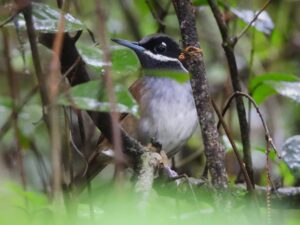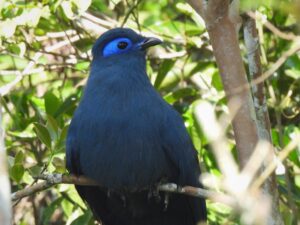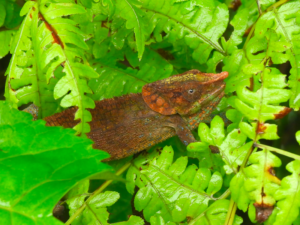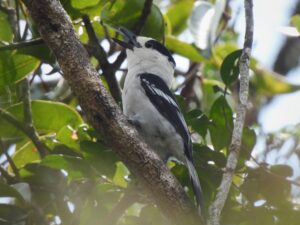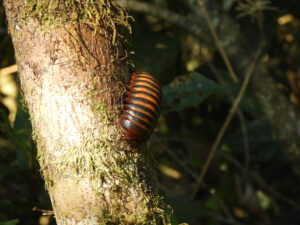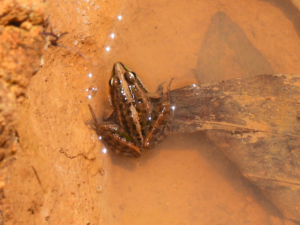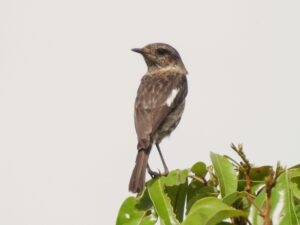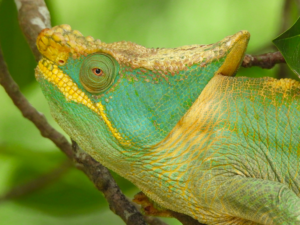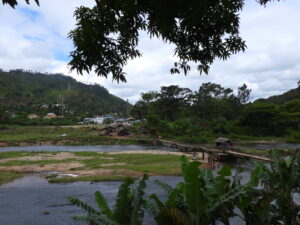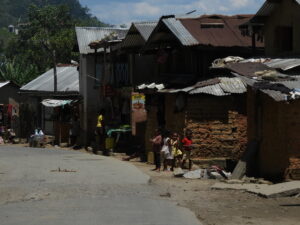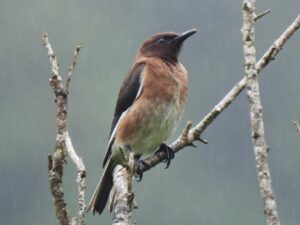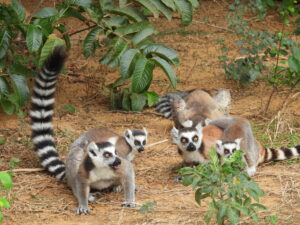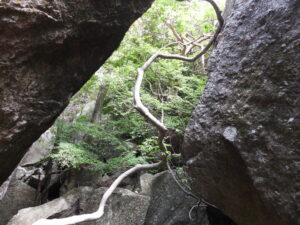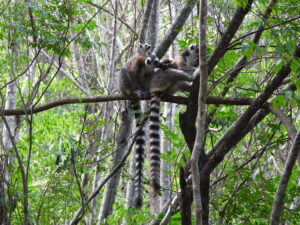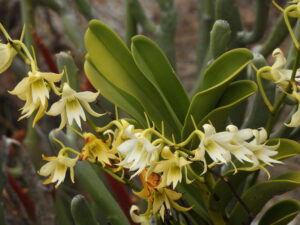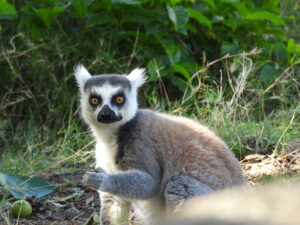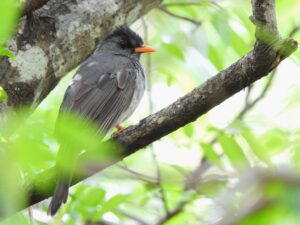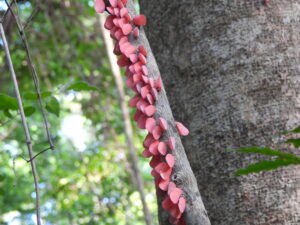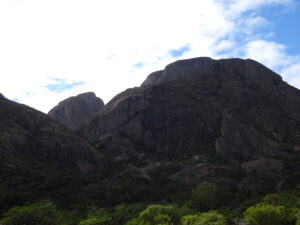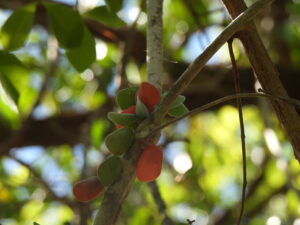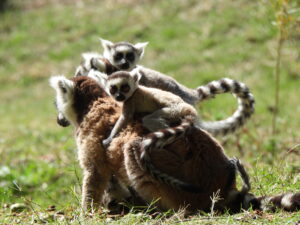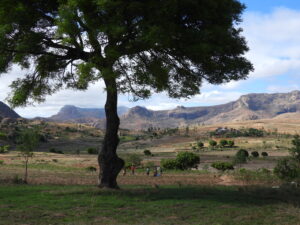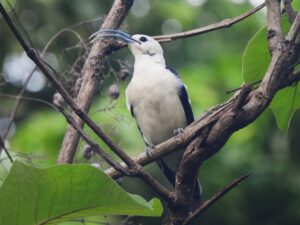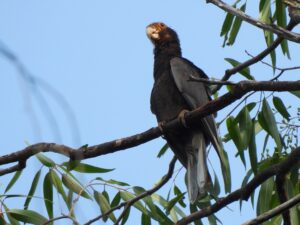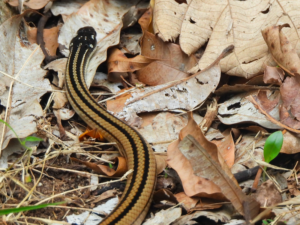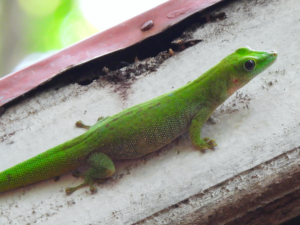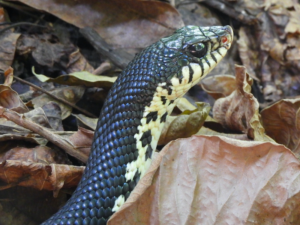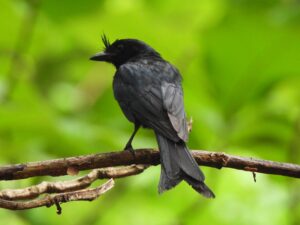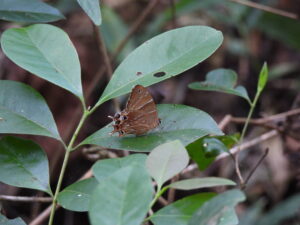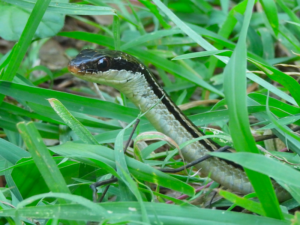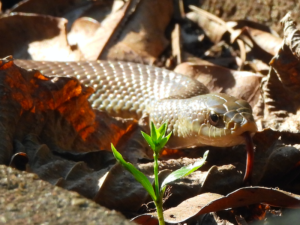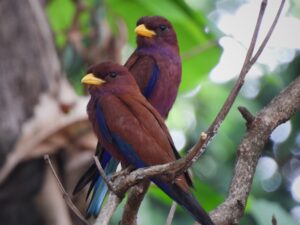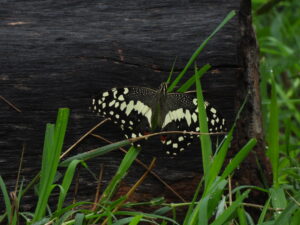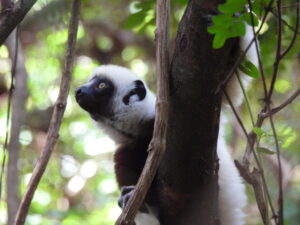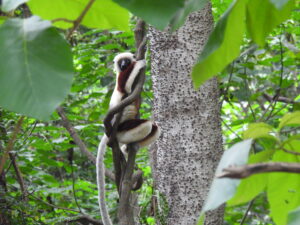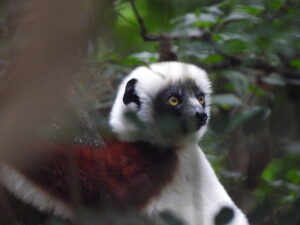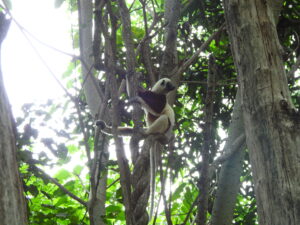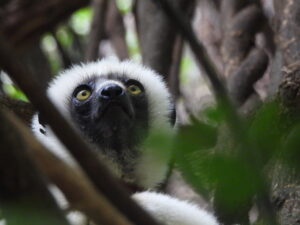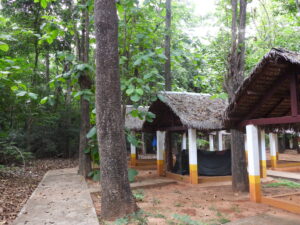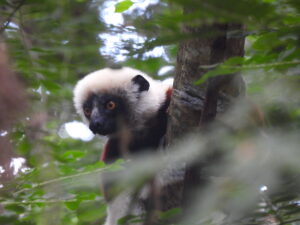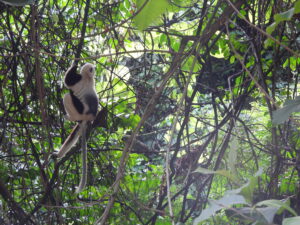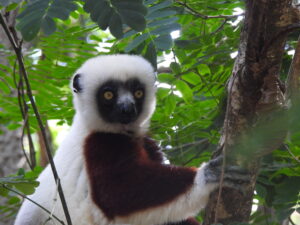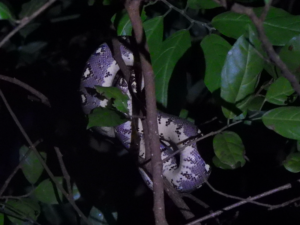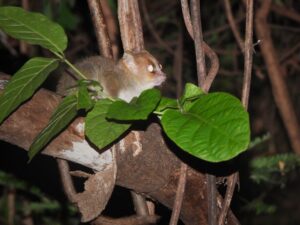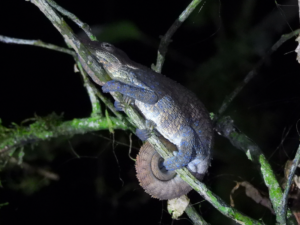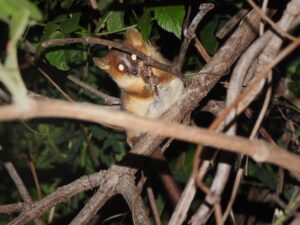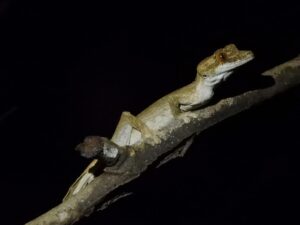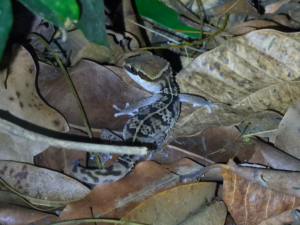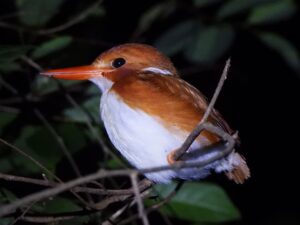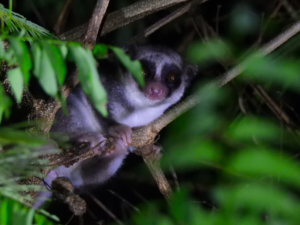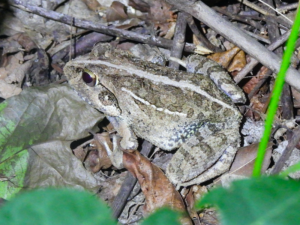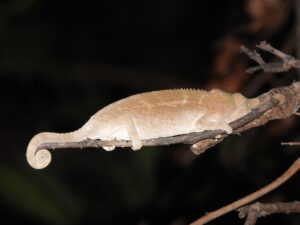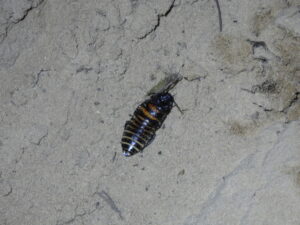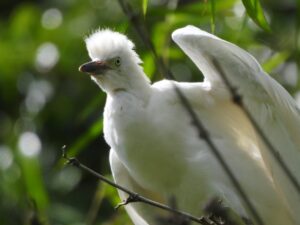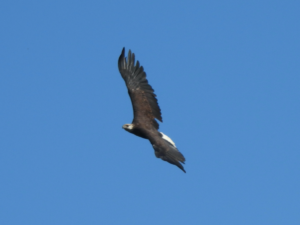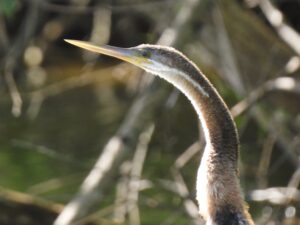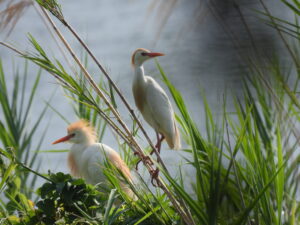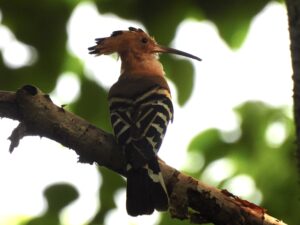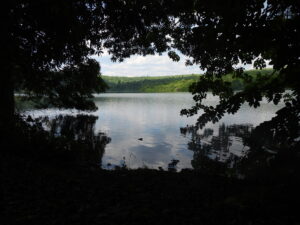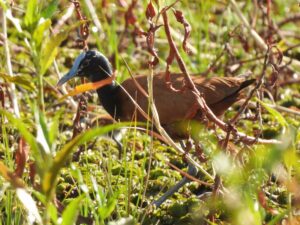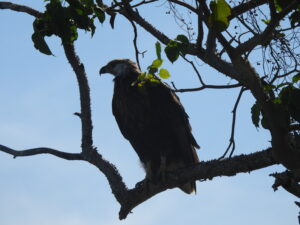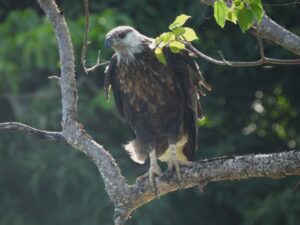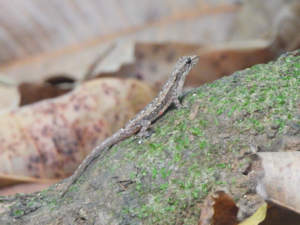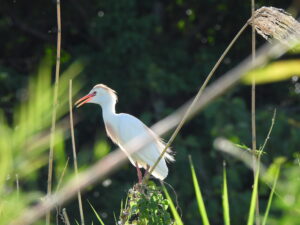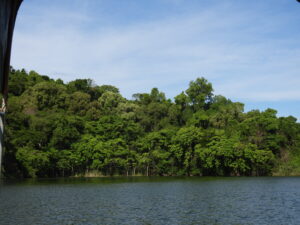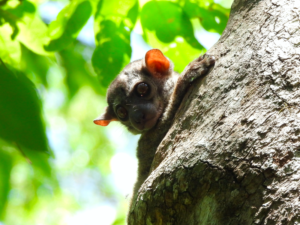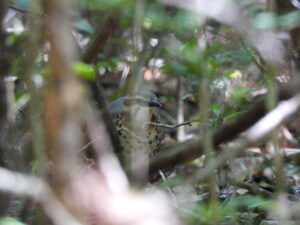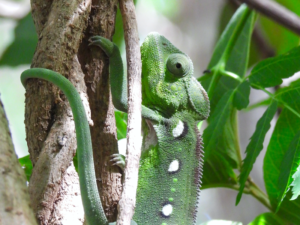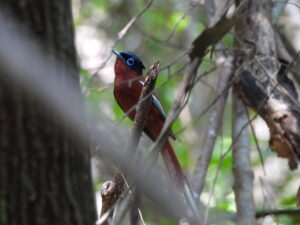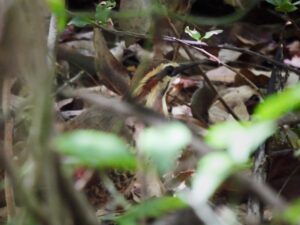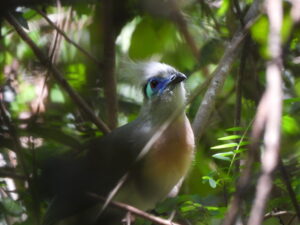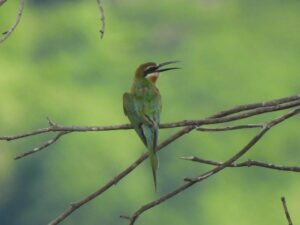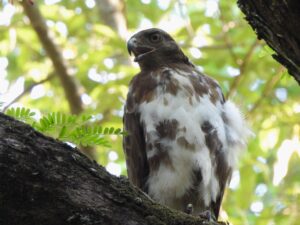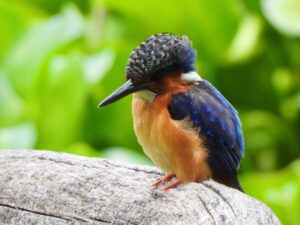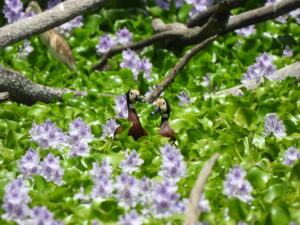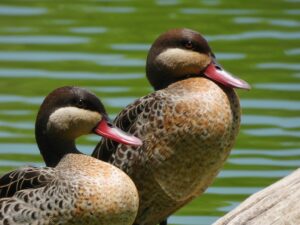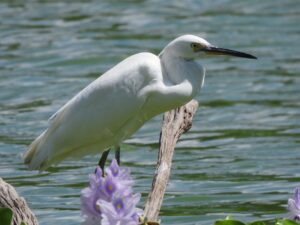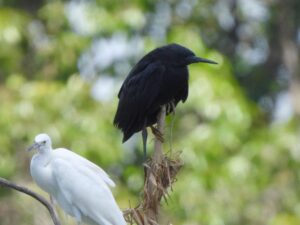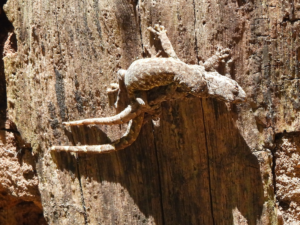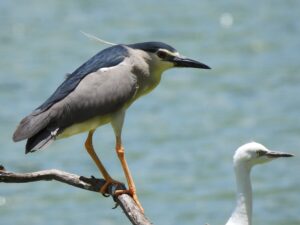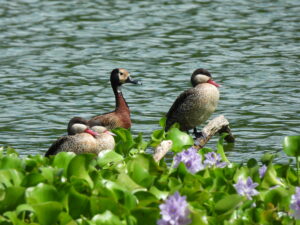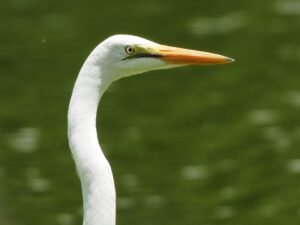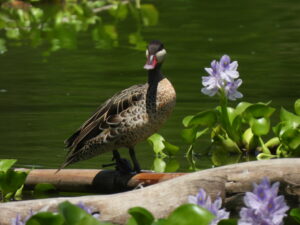Madagascar
Chronicle
5 Nov – 17 Dec 2023
A foggy morning at Centre ValBio, 10 Nov 2023
Ranomafana National Park 6 Nov – 2 Dec 2023
Arriving to Madagascar was not an easy task. I left home in Helsinki on 1st Nov with a Turkish Airlines three-flight booking. A delayed flight from Istanbul to Mauritius caused me to miss the connecting flight and stay in the island for several days. Some productive days later (see the trip report here), I was redirected to a new flight to Antananarivo on 5th Nov, where I got a visa on arrival. My research team suggested I would get door-to-door transfers to avoid issues on my arrival as political unrest had grown violence in the capital city prior to the elections on my arrival date. An intermediary from University to Antananarivo picked me up at the airport and drove me to cozy Maison Lovasoa in downtown Tana, where I stayed overnight. At 06:00 the next day, a jeep truck with two drivers and my assistant Midou were waiting for me down Lovasoa.
No words can explain how strenuous road trips can be in Madagascar. My drive to Ranomafana was quite entertaining, as my first glimpse of Madagascar’s forest-depleted red lands and villages abstracted me. Hiring a private car as I did is an expensive resource that surely make sense as long as the budget allows it — other transport methods can be unsafe and uncomfortable, with extremely high temperatures and in some cases not enough space to fit one’s body. However, deluxe transport methods are not magic and do not avoid the terrible road conditions or the extremely long times it takes to move through not that long distances — Tana to Ranomafana took 11:30 h despite being 400 km apart. I never used private means of transport again and will explain the alternatives I took (and their perks and downsides).
Views of NamanaBe hall in Centre ValBio, 7 Nov 2023
Centre ValBio
Research Institute and Campus belonging to Stony Brook University, located next to the gate of Ranomafana National Park. Research efforts mostly focus on conserving Madagascar biodiversity through local capacity-building (see here).
As far as I know, accommodation in Centre ValBio is only open for researchers. Cutting-edge labs, lecture rooms, a restaurant, very comfortable rooms and a labyrinth of terraces and gardens made me feel a dream during my stay. Located in the Namorona river side, the sound of the waterfalls breaking down the valley and the rainforest fogs filled the space.
I stayed in Centre ValBio for most of my stay in Ranomafana (besides several expeditions camping in the forest) and arranged many of my transfers and tours those days with the center staff. I was assigned field guides on site and got a one month-long research permit to enter Ranomafana National Park. While this specific situation may not apply to readers planning to go to Madagascar, note that entrance tickets and local guides are mandatory to visit National Parks in all cases — both could be arranged at the headquarters on arrival —, and that National Parks currently remain closed to the public at night. Moreover, the road crossing Centre ValBio and Ranomafana (RN25) is filled with resorts that could result in a similar overall experience. Down the road, Ranomafana village offers a wider range of accommodations.
The facilities of ValBio held some wildlife that became usual suspects. A small roof under our room was the nesting site of a pair of Malagasy kestrels that had three grown-up fledglings. A nest of Nelicourvi weavers hung in the restaurant terrace, where red fodies and Malagasy bulbuls marked their territories. A pair of Madagascar buzzards often soared over, sometimes chased by the kestrels or by some fierce crested drongo that usually sat on the reception terrace during the rain. A couple of Madagascar wagtails were usually catching insects on the roof and Madagascar magpie-robins on the garden soil, while several pairs of Mascarene martin nested on the entrance roof by the road.
My short walks in chilly weather under the first lights of the day to the restaurant for breakfast before heading to the field usually resulted in most of these encounters. On longer stays in the center, I made sure I found myself a good spot to have a look at the forest while working. Souimanga sunbirds and Malagasy sunbirds often showed up in a dead tree of the garden and the song of Malagasy cuckoos could be heard day and night. Malagasy palm swifts and Malagasy swifts often flew over ValBio, the later usually coming from the waterfalls on foggy days.
At a certain point, mixed-species flocks would show up, including my first sights of many species: Malagasy white-eye, tylas vanga, blue vanga, white-headed vanga, Madagascar cuckooshrike and spectacled tetraka. Other exciting sights involved red-vented lemurs, Ranomafana nosed chameleon, or comet moth (Argema mittrei)
The real wildlife show in ValBio takes place at night. The temperatures drop, the volume of frogs and insects boosts and the lights seem to attract every single creature of the forest. I have found beetles, moths, dragonflies, stick insects, cockroaches, spiders and all other sorts of arthropods of colors, shapes and sizes I never imagined. Several Madagascar emperor moths (Bunaea aslauga) ended up inside the building. Unfortunately, my knowledge on Malagasy arthropods is limited to a handful of species, but a big diversity of charismatic creatures roamed around at night and were swept out in the morning by the cleaning staff. We experienced a couple of nights where certain ant species swarmed, millions crawling in the glasses of all doors and windows of ValBio. The nights were a constant reminder that we were staying in the middle of the rainforest after all.
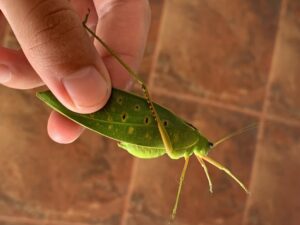
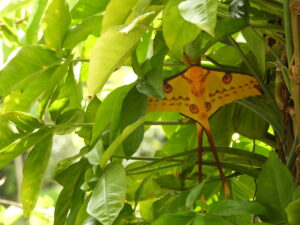
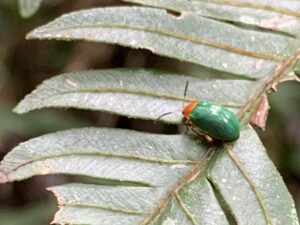
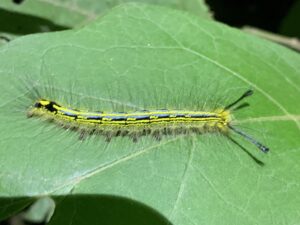
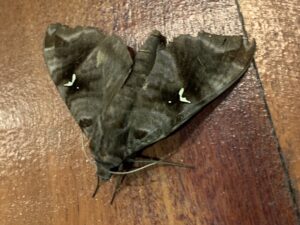
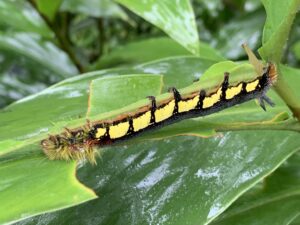
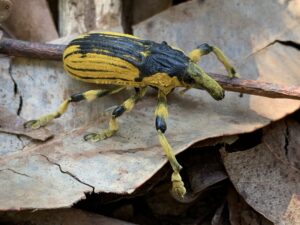
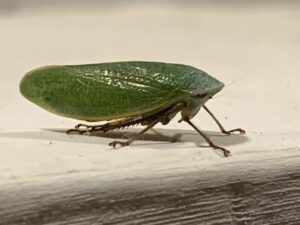
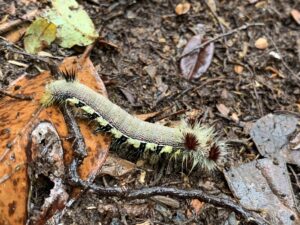
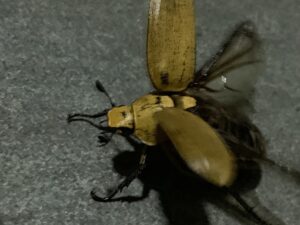
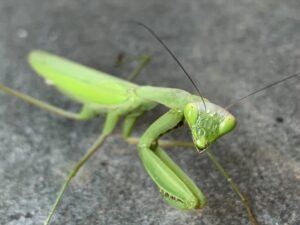
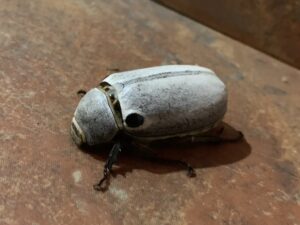
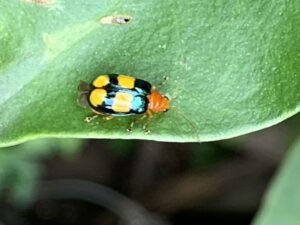
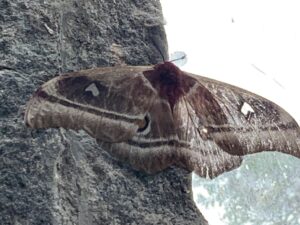
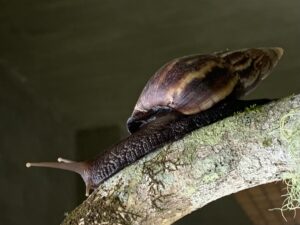
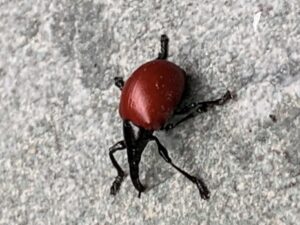
If we were not too tired and the weather allowed, Lola and I would grab our frontlights and walked around the road. While Ranomafana National Park remains closed at night, the road is off the park limits. Security staff seemed to be a bit hesitant to have us walking around at night, but other international researchers enjoyed doing it too. These walks made us connect with an impressive diversity of chameleons and even more insects.
Bridge crossing past headquarters, 16 Nov 2023
Talatakely
Former Tanala village in the entrance area of Ranomafana National Park, just crossing the bridge from the Headquarters. Currently a bamboo-dominated secondary forest with a network of trails for visitors (see here).
Talatakely was the part of the forest I visited the most, as it is conveniently located at the entrance of the park. Next to the road, there is a headquarters-like area with some little stores — I really liked talented Alain Rasolo’s art gallery. A trail starts down towards the river, crossing the territories of some red fodies and Madagascar paradise flycatchers and leading to the checkpoint. After the checkpoint, some bushes close to the river are reliable for giraffe weevils (Trachelophorus giraffa). Then, a bridge crossed Namorona river over some of the most paradisiac waterfalls I have ever seen. On the other side, Talatakely.
I have had numerous encounters with interesting species on my walks in Talatakely. The most memorable ones happened on my first week of research inside Ranomafana National Park. I have set some camera traps with bait to monitor scavengers and sat quietly after hearing unfamiliar calls. My team kept walking back to the headquarters, so I stayed behind for a while. Before leaving, my guide had shown us an empty bird nest, a tunnel carved in the trailside slope. Then the calling bird revealed itself: a smart pitta-like ground roller, moving through logs and twigs in the understory. I managed to retrieve my camera and take some shots before it disappeared. Wow. It was getting dark, so I packed up to leave but stopped when I noticed two creatures moving fast like invisible flashes towards my baited trail cameras. Two ring-tailed vontsiras, endemic mongooses, concealed with the background. I ran back to my team with goosebumps all over my body.
I was anxious to retrieve the trail camera at the pitta-like ground roller spot and check out the footage. We had a new guide for that day, a novel guy doing great as he was learning the job. Before getting to the bait spot, he stopped all of us as he just saw a “big special bird”. He could not recall its name in English or French as we waited for it to show up, looking down the understory in all directions. Suddently, an explosion of white revealed the flight of a Madagascar crested ibis jumping from the forest floor at very close distance, heading up above the canopy. I did not expect to encounter this species coincidentally during my research trip and did not contact it again. The camera did not have footage of the ground roller, but captured the ring-tailed vontsiras and the crested ibis too!
Talatakely was fundamental for my project as it is a stronghold for giant bamboo. In fact, only one individual of greater bamboo lemur remains in Ranomafana National Park, the female Simone, who has never met any individual of her species other than her father. Unsuccessful reintroduction programs have failed to bring more individuals into the National Park. Simone forages and lives with one of the few troops of golden bamboo lemur of Talatakely. After weeks working in the area, I only managed to see Simone and her ‘troopmates’ on my last day in Ranomafana, when I joined the bamboo lemur monitoring team.
Sharing an entire day with the bamboo lemur troop gave me insights about ecotourism in Madagascar and the compromises that this industry makes to try to sustain conservation efforts. The monitoring team made no effort to find the lemurs on our arrival, as they know their forage area. So do the National Park guides, which bring hundreds of tourists every day to see these same lemurs. Simone is the star of the show and tour guides would gave her a giant bamboo shot to have her sitting on the floor while all tourists approached her at an arm-length. Seemingly unbothered, Simone would end up her meal, climb to some bamboo culm and sit for a while watching life go past. The whole show gave me the impression of a zoo, but the income that tourists (and researchers) bring to Ranomafana and other National Parks seems to promote the effectivity of land protection.
Camping situation in Vatoharanana, 22 Nov 2023
Vatoharanana
Well-conserved montane forest area deep inside Ranomafana National Park holding several bamboo lemur populations. Apparently also a former Tanala settlement. There is a camp for researchers and visitors (see here).
Vatoharanana is another hotspot of bamboo lemur research, as it holds good numbers of lesser and golden bamboo lemurs and a troop of greater bamboo lemurs lived in the area until last decade. However, it can only be reached after a walk of several hours through the forest, so it is usually off reach for the general public and single-day visits.
Midou, Lola, Georges and I headed to the camp, where we met another team led by Théo. Cook Solo joined too and prepared our meals throughout the expedition. Life at the camp was slow and delightful and we ended our survey days dumping our feet in a cold creek surrounded by Mantidactylus frogs.
Work days have not been too productive bird-wise throughout my stay, as I put the focus on vegetation. Some encounters with O’Shaughnessy’s chameleons, leaf chameleons, mighty and loud black-and-white ruffed lemurs and troops of red-vented lemurs and red-bellied lemurs approaching us were memorable. However, nights at the camp were unforgettable. We connected with many giant crickets and giant pill-bugs, different snakes and chameleons, Tanala tufted-tailed rat, nesting spectacled tetrakas, dwarf-lemurs and a stunning Madagascar sunset moth (Chrysiridia rhipheus) — I would only see them flying 30 m up in the canopy in the daytime. As we come back from night walks, the guides pointed us the trees where they had seen legendary animals, such as aye-aye and fosa. As we ate Solo’s fantastic vary (rice), a Malagasy civet skulked into the camp looking for some leftovers — an endemic, vulnerable species which is usually very hard to spot! At night, I would distinguish the hoots of a Madagascar scops-owl from my tent among the nocturnal jungle uproar.
The long walks between Talatakely and Vatoharanana provided some incredible sights too, as we had the time to make some stops and look for fauna. On our way in, we crossed a couple of young Milne-Edward’s sifakas sleeping. On our way back, Théo joined us and whispered to the birds. We managed to see velvet asity, cuckoo-roller, a family of red-tailed vangas, blue vanga, tylas vanga, Ward’s flycatchers and Madagascar cuckooshrikes, most in mixed-species flocks. We also glimpsed a pitta-like ground roller — ‘Madagascar’s most beautiful bird’, as Théo always said’ — and a Henst’s goshawk calling as it flew above us over the canopy. Before reaching Talatakely again, I also found some pure white crested ibis feathers.
The logistics for the camp were arranged in Centre ValBio and I thought the research permit would ease the process. However, the only other group camping were a tourist and his personal cook and guide. Therefore, I imagine there are ways to camp in Vatoharanana and stay overnight inside the National Park, but I do not know how it can be arranged.
Opening in the middle of the forest, 18 Nov 2023
Vohiparara-Sahamalaotra
Trail network on the north side of the road in Ranomafana National Park starting in the Vohiparara village at the west. Montane primary and secondary forests hold the best spots to connect with several rare bird and lemur species (see here).
Some of my sample points were around Vohiparara, and I arranged an expedition to the village with Midou, Georges and Solo. We set camp in a village house (quite literally, we set the tent inside an empty daub house to avoid malaria). It seemed that few foreigners had stayed in Vohiparara lately, so I soon caught the attention of all the kids in town. From the village we would walk long distances into the secondary forest, inside and outside the National Park. Here I got particularly good views of blue coua, red-fronted coua (I also found a bird killed by a raptor), cuckoo-roller and common jery. Georges knew the holes where small-toothed sportive lemurs spend the daytime in Vohiparara trails. I eventually spotted a female Madagascar paradise flycatcher incubating at her nest and another pitta-like ground roller nest, the bird feeding closeby.
I visited Sahamalaotra trail with Théo and bird researcher Alexa Lightbourn for some bird surveys and had the most bird-productive days in Ranomafana despite the unfavorable weather. His expertise allowed connecting with new species such as rufous-headed ground roller, dark newtonia, Rand’s warbler, or cryptic warbler (only discovered to western science in 1992). Amidst the drizzle and fog, we got to see cracking forest rock thrush, Pollen’s vanga, Madagascar blue pigeons, long-billed bernierias, Crossley’s vanga and a glimpse of two common sunbird-asities. A troop of Milne-Edward’s sifakas live in the area and some red-vented lemurs, mantella frogs and several chameleon species could be seen, some of them walking from Sahamalaotra gate to Centre ValBio through the road — some areas of this road section provide great views and opportunities for wildlife!
These points at the north side of Ranomafana National Park yielded the most productive walks in terms of birds. Illegal gold mining had impacted the security in this side of the park, but the trails of Vohiparara and Sahamalaotra are safe. Many tour operators bring ornithologists to these areas as the montane forests here hold good populations of Ranomafana specialties that are seldom seen elsewhere in Madagascar.
Landscape in Ranomafana, 8 Nov 2023
Ranomafana village
Main village in Ranomafana National Park area and hub for locals and tourists. Famous for its thermal pools next to Namorona river. Ranomafana Arboretum and the gardens of some lodges bear some good wildlife (see here).
Few of my sampling points were down by Ranomafana village, but I mostly went down town to do some shopping or chill with friends on free days. There is something picturesque about this village, surrounded by forested peaks. Getting there from Centre ValBio was straightforward: a bus drove workers from their homes to work in ValBio and back and we could hop in. If we missed it, we would stop some of the many taxi-brousses driving up and down the road. Besides the touristic thermal pools and resorts, there is a nice local market worth visiting, with shops that extend to the bridge on certain days.
There is a garden with large trees, bamboo and lily ponds opposite to the village on the other side of the river. Common mynas, broad-billed rollers, souimanga sunbirds and even Chabert’s vangas could be seen there often. Greater and lesser vasa parrots could be seen in flight in the distant mountain. One day I crossed upon a man who kept nine massive Parson’s chameleons in a tree, drawing the attention of everyone passing by.
I did not visit Ranomafana arboretum but visited a local’s well curated garden, where I saw several red fodies and Madagascar munias. The water flowing through the garden cascaded to some rice paddies, where I connected with a Malagasy kingfisher and a common moorhen.
Canopy view somewhere in Vatoharanana, Ranomafana National Park, 21 Nov 2023
Centre ValBio’s staff helped me organize a day trip southwards. I rented a 4WD car and driver for the day and headed to Ambalavao, a beautiful town some 3 h (110 km) away from Centre ValBio in the dry central plateau of Madagascar. Ambalavao surely receives visitors as it is located somewhere midway between Tana and Toliara, two main hubs of Madagascar. A network of locally-owned businesses have started a side activity consisting in showing tourists what they do and how they do it: peanuts, silk, or paper can be bought after going through the whole production chain. Our day actually started (and had as a highlight) a visit to a forest some 12 km south.
Views from top of Anja hill, 25 Nov 2023
Anja Community Reserve
Forest patch around a massif surrounded by barren dry plains in southeastern Madagascar. Although the main attraction are tame ring-tailed lemurs, the singular fauna and flora and the rocky landscape on the way to the top make it worth a visit (see here).
The park has an entrance fee for foreigners of MGA 55000, additional, to the route. Different routes can be chosen at different fares, length and duration. We chose the route of 2:30 h (MGA 120000 for 3 people), although it turned out to last less than 2 h.
The highlight of the park are the widespread ring-tailed lemurs, which are to be found in good numbers everywhere in the forest. The guides stop extensively so that tourists get to be around the lemurs and explain some life facts about them. They also make several stops throughout the route to show animals thay have located, in our case a female and a male Oustalet’s chameleon and a flatid leaf bug.
The views improve getting higher, as the route goes through different crevices, caves and hills. The forest is full of Madagascar bulbuls, Madagascar magpie-robins and calling Madagascar hoopoes. Many reptiles were seen in the route, including Grandidier’s Madagascar swift, Dumeril’s Madagascar swift and Bernier’s striped snake.
Up the tree canopy in the hills the avifauna is very different: tens of yellow-billed kites and many couples of pied crows fly all around and sit in trees and rocks, as so does a couple of light morph Malagasy kestrels. The views from the top are stunning and the flora includes very interesting orchids and succulents.
Dry plains and hills around Anja Community Reserve, 25 Nov 2023
The team left Ranomafana on 1st Dec. We planned to stop one of the ‘informal’ taxi-brousses driving between nearby cities early in the morning towards Fianarantsoa — note that there are significantly less taxi-brousses driving on Sundays. After an hour or so, we managed to put our luggage in and fit in the third taxi-brousse that stopped by for a very affordable amount. Some 1.30 h later we reached Fianarantsoa. Because we carried a lot of heavy luggage, we used a pousse-pousse — a pulled rickshaw — and walked next to it from the taxi-brousse arrival point to the next taxi-brousse station, this time from a company called Cotisse.
Cotisse is one of the national public transport operators of Madagascar. On our experience, it was a reliable, safe taxi-brousse service between cities and offered a range of prices depending on the seats and leg space. We paid some MGA 50000 per person one way. All these taxi-brousses stop for meals at designated local restaurants on the road, in the case of Cotisse somewhat above average in terms of quality as compared to restaurants elsewhere throughout the trip. We made it to Tana 10 h later and transfered via taxi (extremely expensive in Tana!) to Hotel Sakamanga, where Lola and I had a great time. We stayed around for some days working until she left Madagascar.
Ankarafantsika National Park 6 – 10 Dec 2024
I planned to head north on 6th Dec. I arranged some things in Tana beforehand: booked in Hotel Sakamanga and Madagascar Underground for the rest of my stay, bought a Cotisse ticket at their office in Tana downtown (in Hotel Tripolitsa, but ask around and beware that finding it can be difficult in the chaos of the city) and left some luggage in town to avoid extra hassle during my camping trip.
A taxi brought me to Cotisse taxi-brousse station and I departed towards Mahajanga up northwest (MGA 65000). The ride was perhaps as comfortable as it gets in Madagascar, but the heat was scorching. Paying the whole ticket and letting the drivers know in advance, one can stop anywhere along the route — things get complicated on the way back, as the same taxi-brousses might be full by the time they stop by, so I thought to go all the way to Mahajanga and then back to Tana with Cotisse.
After driving for 10 h, I hopped off in Ankarafantsika National Park. I first headed to the Park Office: camping is an option and I could set my tent just in the headquarters outside the National Park border. Entering the park means a daily fee of MGA 55000 plus the added services of a guide paid by tour, but everything can be arranged on-site. Note that temperatures were well above 35ºC all day long, so the cold-water showers in the bathroom area next to a small restaurant were very much appreciated. Heavy rain episodes happened only at night and sporadically, but were not a problem as the camping spots have built-in roofs.
Camping area in Ampijoroa, 7 Dec 2023
Park Headquarters
Formerly known as Ampijoroa Forestry Station, located next to road RN4 between Tana and Mahajanga. The office offers an array of accommodations at walking distance to all tours, unlike the lodges of the park. Campers are welcome (see here).
The camping area is located between the Park office, the road and a small village. I was the only visitor camping at the time and a couple of curious teenagers liked to roam around, at first asking for money. Although I felt uncomfortable to leave my stuff at the tent over the day traveling alone, we ended up getting along and hung out often and they would wait for me by my tent once they finished their work shifts at dusk.
I spent a good amount of time at camp, writing and going through my field notes, chilling at the restaurant and becoming friends with the staff, resting the occasional dizziness and runny belly and hanging out with these new friends of mine, who were keen to learn some English. Hours passed by surrounded by Koch’s giant day geckos, Cuvier’s Madagascar swifts, western girdled lizards, four-striped snakes and Madagascar giant hognose snakes — none of them aggressive or harmful to humans.
Bird-wise, there were several broad-billed rollers nesting in the area, crested drongos usually hunting moths and butterflies and bald greater vasa parrots calling loudly and often exposing from the top of the trees. At certain times of the day, especially at night, the haunting baby-like calls of numerous sickle-billed vangas announced their arrival.
Every now and then I would have some sight of other remarkable species passing by, such as the white-faced whistling duck, the wonderful Madagascar fish eagle and a poorly seen dark-morph Eleonora’s/sooty falcon, best left unidentified.
The most exciting inhabitant of the camp was undoubtedly the Coquerel’s sifaka. A troop of half a dozen individuals foraged around the camp at different times every day. In the morning, a couple of sifakas would sit at the very top of the highest trees, foraging for food. Then, at some point, they would all show up climbing loudly through the vegetation. They stood motionless when they got too close to me or my tent and we observed each other for prolonged times. Sifakas have a special beauty which is hard to explain. These furry little climbing men of the dry forest are critically endangered and restricted to these and few other areas of the island’s northwest.
Because the headquarters area lies right at the border of the National Park, one can camp overnight without problems. I would bring the torch and walk around at night looking for mouse lemurs, geckos and moths. One day my guide offered a night tour so we walked south, bordering the National Park boundaries, at sunset, while spotting numerous sickle-billed vangas at roost and two mongoose lemurs feeding on mangos. The walk was fantastic, as he brought me to a roost of a pair of Madagascar pygmy kingfishers, which were high on my top list despite eluding me for the whole trip.
Although we had a hard time with our spotlights going through a very dense swarrm of flying ants, we connected with great species including the localized rhinoceros chameleon, Stumpf’s ground gecko, Günther’s flat-tailed gecko, Nosy Komba ground boa, Madagascar bullfrog, hissing cockroaches and many more. I also got to spot the two mouse lemur species in the area: the gray mouse lemur and the lake-endemic golden-brown mouse lemur, while Milne-Edward’s sportive lemurs and western fat-tailed dwarf lemur were also seen.
A constant at camp was the incredibly high temperature and humidity, which made sleeping difficult — luckily, I ended up tired enough daily to not notice too much. I don’t know what is the situation like in the National Park bungalows in the headquarters, but camping was a good option after all.
Dreamy, sacred Lake Ravelobe, 7 Dec 2023
Lake Ravelobe
Lake next to the headquarters populated by Nile crocodiles and aquatic bird species. Sacred to the Sakalava peoples, a ritual takes place in the area once a year and is likely the reason behind its good conservation status (see here).
The lake is only some meters away from the other side of the road coming from the headquarters. A clearing closeby is next to a colony of hundreds of western cattle egrets with some Squacco herons mixed in. I would walk down the shore in the morning, almost every single day warned by locals because of the presence of ferocious Nile crocodiles (that I never saw). Instead, a family of common brown lemurs, two cuckoo-rollers on the nest, two couples of Madagascar hoopoes, some territorial Madagascar magpie-robin and Malagasy kingfisher were to be seen just in the forested area between the lake and the road. Malagasy coucals skulked but were easy to notice too.
One of the activities in Ankarafantsika National Park is a boat tour in the lake, a great opportunity to see the specialties of Ravelobe (MGA 50000 per tour plus daily park entrance fee). The boat departs from a small pier close to the camp. My guide suggested me to go at 15.00.
The tour borders a big part of the lake shore. First heading north, where we connected with several olive bee-eaters and Sakalava weavers. A bit more far north, a water dam has a small picturesque tree in the middle of the water. Suddenly, a massive Madagascar fish eagle (Ichtyophagus vociferoides) approached us and sat in that specific tree, as the boat driver gets closer and closer to it. The sight was awesome, even more considering how extremely rare this species is — estimated at around 350 individuals left globally. I got shocked later when I realized that the proportion of pictures of the species on the internet and guide books are of a bird sitting in this one tree is incredibly high.
Continuing through the other shore, we connected with even more Squacco herons and cattle egrets, some striated herons fishing from the shore, a moorhen and a purple heron. The biggest surprise came as an African darter diving, concealed in some cut reeds and plants. A bit further away we got great looks of a bird (perhaps the same) out of the water.
On the south end of the lake, the boat approaches a mat of floating plants. A purple heron fished from the shore close to where we stop and, suddenly, a fierce Madagascar jacana scared it away, a protective parent of two small chicks. An obliging species on a classic location, providing a tender moment.
Further on, we passed by the western cattle egret colony, with hundreds of birds. This colony seems monospecific, although some Squacco herons rest in the reeds along. Only when we reach the pier, my guide and boat-driver point at once a much welcome last-minute Malagasy pond-heron.
The common thread of the whole tour is the incredible views of the lake. Ravelobe is sacred and cherished to the Sakalava peoples and fady (taboo) has preserved such a magical, beautiful place. I kept hearing stories of crocodiles eating kids and adults not too long ago, including from my guide and boat driver. The message is clear: beware. However, during the boat ride these guys would wave hello to women showering in the shore of the lake, while men literally had the water up to their neck fishing, away from the shore, with limited protection.
Dry forest on white sand, 7 Dec 2023
Circuit Coquereli
A circular tour starting from the headquarters into the east, covering dry forest on sandy soils. Several lemur species, couas and mesites can be seen. An extension of this circuit goes to a picturesque canyon with limited interest for birdwatching (see here).
As it name suggests, I imagine Circuit Coquereli has the Coquerel’s sifaka as its highlight. My guide knew I had been pretty much living around a sifaka family in my tent, so after starting at 06:00, he kindly focused on other species. Lemur-wise, he showed me a western woolly lemur and a Milne-Edward’s sportive lemur, both at roost.
Bird-wise, the morning was promising. The forest was full of bird songs in the early morning, in Madagascar standarts. Malagasy turtle doves, crested couas, Madagascar cuckoos, cuckoo-roller and common newtonia were heard during our walk. Males of Malagasy paradise flycatchers were also present and showed off their fine looks.
I had several coua targets as none of the species here are present in Ranomafana. All of them obliged. Crested couas were easy to spot by their laser gun-like call, but some birds provided great views. A red-capped coua was seen sunbathing in the middle of the trail. Several Coquerel’s couas were heard from the forest, with a bird foraging in the understory.
A major target took us some time. The white-breasted mesite is only known from three different sites in Madagascar and this dry forest is one of them. After a good half an hour paying attention to any bird call, some sort of a “hush” alerted my guide. We went into a narrow path in complete silence and, in the blink of an eye, were surrounded by calling white-breasted mesites. This target would mark the sixth and last Madagascar endemic family seen in the trip. Regardless, and despite the difficulty of getting good photographs due to the skulky behavior, understory vegetation and camouflage of the bird, the mesites provided incredible views and performed their odd behavior, showing up in pairs and groups of three.
After noting a calling rufous vanga, another call stopped our walk. A female Van Dam’s vanga showed up incredibly close to us under a tree. This endangered species is very scarce and finds its stronghold in these dry forests. My guide was surprised this cracking bird took us such little effort. The last avian highlight was a Madagascar sparrowhawk, which flew over us close with a prey and sat just some trees away to feed on it.
Red soils on the junction to Retendrika, 7 Dec 2023
Circuit Retendrika
Circular walk starting on the road in the north side of Lake Ravelobe. Relatively moist forest, with tall broadleaf canopies on sandy soils. This is the best area to locate Schlegel’s asity (see here).
Circuit Retendrika takes place in the rather humid forest of the north side of Lake Ravelobe. My visit started at 06:00 and the walk to the junction on the north part of Ravelobe goes through the little tree where we had seen the Madagascar fish eagle, and the trees where several Sakalava weavers bred. Olive bee-eaters and Malagasy sunbirds foraged in the trees and Mascarene martins caught insects over the water surface. On this area, locals showed me two giant colorful stick insects of an endemic species (Achrioptera maroloko) on a walk at some point.
Turning right into the trail in the junction, my guide heard a Madagascar green pigeon and we managed to see it for a split second, feeding on a fruiting tree. A second bird flew over after it. Common jeries and Malagasy bulbuls were also present.
Once inside the forest, it felt more calm than Circuit Coquereli area. Malagasy paradise flycatchers, Malagasy bulbuls and crested couas were among the few noticeable species. A Madagascar buzzard called continuously from a tree. We also spotted a fine male and female Frances’s sparrowhawk.
The top bird of this circuit hardly obliged. The extremely localized, stunning Schlegel’s asity breeds in this forest area. However, the best time of the year to see them is over and they are now silent and wary, just after breeding season. Although we looked for it for hours, we only heard a male singing from distance. It would stop singing as soon as we got closer and start again from a great distance some minutes later. No glimpse of this stunner for us.
Canopy over Circuit Retendrika, Ankarafantsika National Park, 7 Dec 2023
At a certain point I had planned to come back to Tana and I did happily knowing that Ankarafantsika National Park had obliged with most of my targets. Also I did not have any SIM card or way to access internet and I had some work stuff running behind — and family and friends to contact. My plan was to stop a taxi-brousse heading to Mahajanga and once there grab another one from Cotisse or similar towards Tana.
This stretch of the trip showed the real face of traveling in Madagascar, putting everyone’s patience to test. I managed to hop in a packed taxi-brousse, with several goats in the trunk. The trip should have taken 3 h (115 km) and the extremely low price seemed like a good compromise. However, a bridge had broken overnight halfway some 2 h later. Different vehicles gathered on the road and the drivers of our taxi-brousse relocated us in different cars, vans and trucks (which did not ask us for money). Unluckily, I did not fit in the new spot and had a very hard time for the following 3 h while trying to entertain myself with several Namaqua doves seen on the road, the interesting landscapes and villages, with the unique Sakalava architecture and chatting with a local former policeman.
Arriving to Mahajanga was a great relief. The van dropped me in Cotisse station and I bought a ticket for the overnight taxi-brousse to Tana — I was already down the rabbit hole. A tuk-tuk brought me to the beach area where the famous Mahajanga baobab (funnily, of the only African baobab species despite most species being endemic to Madagascar). I walked the promenade by the ocean, where I found no tourists. A bit up north, I had lunch at Le Guest, a great restaurant at walking distance from the baobab and enjoyed some drinks while texting my family (they have internet!) and writing notes in front of the best Indian Ocean views.
I stopped another tuk-tuk and hopped back to Cotisse. This would be the last taxi-brousse epic of the trip, but it ended up being the worst one. Taxi-brousses of these companies travel in caravans, one after the other to avoid incidents on the road — bandits were a reality in some roads of the island still at the time of my visit. This means that a flat tire in one of the taxi-brousses would stop all three until the problem is fixed. Indeed, we encountered numerous flat tires and an engine issue during the night, which prolonged a 570 km trip for almost 19 h.
Views of Antananarivo from Maison Lovasoa, 6 Nov 2023
Antananarivo 11-17 Dec 2024
I stayed in Antananarivo at my arrival, both between Ranomafana and Ankarafantsika and before my departure. It is a conveniently located hub at the middle of Madagascar, but the social reality and the logistics for travelling are very different to those in rural areas.
I stayed mostly in Hotel Saka Manga, a great accommodation with a clear European influence downtown Tana. A nice pool in the patio and some beautiful gardens held numerous red fodies and striped day geckos. During my stay I would often venture out in the street, where the peace and the European feeling vanished fast. Heavy traffic, chaos, lots of people in all directions (including many persistently touting at tourists) and an opportunistic but attractive architecture are the charm of Tana. I would go out mostly to fetch cash from the bank and eat. Besides great breakfasts at Bread Mafan’ just next door, I would sometimes walk to Madagascar Underground, a cool youth hostel, to have lunch. As I liked it, I also stayed there for some days.
My stay in Tana was mostly focused on working to meet deadlines of my studies back at home, processing the field surveys and resting for the trips before and after. Plus, venturing out solo was not too attractive, as most taxi drivers were keen to ask me for more money for a one-way short drive than what I had spent on all taxi-brousses together. I found myself a driver who would give me some good prices as long as I relied on him often — he brought me to the airport on my departure day and to a place where I went birdwatching within urban Tana.
Lac Alarobia, 12 Dec 2023
Parc Tsarasaotra
Urban park in Antananarivo with a lake, Lac Alarobia inside. RAMSAR site and relevant wetland as it is the only known breeding colony of Malagasy pond-heron. The park is private and holds mannors, so not all of it is open to public (see here).
Despite leaving at 07:30, the traffic of downtown Tana only allowed me to reach Tsarasaotra at 09:45 for a ride of 5 km! People selling all sorts of things (including caged vasa parrots and gray-headed lovebirds) made the ride interesting. At the park gate I paid the entrange fee of MGA 20000 and entered. The taxi driver would wait for me outside the gate at midday, so I had some hours to explore this urban wetland.
Lac Alarobia was full of life. Numerous white-faced whistling ducks and red-billed teals gave great views. Other numerous birds included moorhens, Malagasy kingfishers and a great diversity of herons: black-crowned night-herons, dimorphic egrets, great egrets, Squacco herons, cattle egrets and Squacco herons. Black herons were not particularly numerous but present.
The gem of this spot is the Malagasy pond-heron, as they hold a colony in the lake which is the only breeding place for the species known to date. In the lily pads of the sides where most herons were and on the reeds in the center of the lake, I could only see few non-breeding birds, some of them even potential as this species can be hard to separate from the Squacco heron and several left unidentified. That was not ideal. I finally managed to find some fine breeding-plumage birds in the reeds of the central island of Lac Alarobia seen from the back (in an area that is perhaps private?).
Suddenly, a familiar call reminding me of the sea sounded from the sky. Indeed. A lesser crested tern had flown in over Lac Alarobia and left east a couple of minutes later. To my understanding, this is the first recording of the species in Antananarivo region of this otherwise coastal and pelagic species.
I only saw two waterfowl species despite six being regularly recorded here and I missed some other goodies in the Park, but my pick-up time had come and I came back to my hotel. I think early November (my arrival dates) would be a better moment to visit this area, as more species gather there. On my walk back, the very last lifer of the trip came as a calling white-throated rail. Despite what I missed, this visit added up to the satisfaction and fulfillment of this awesome field experience and served as a great ending.


